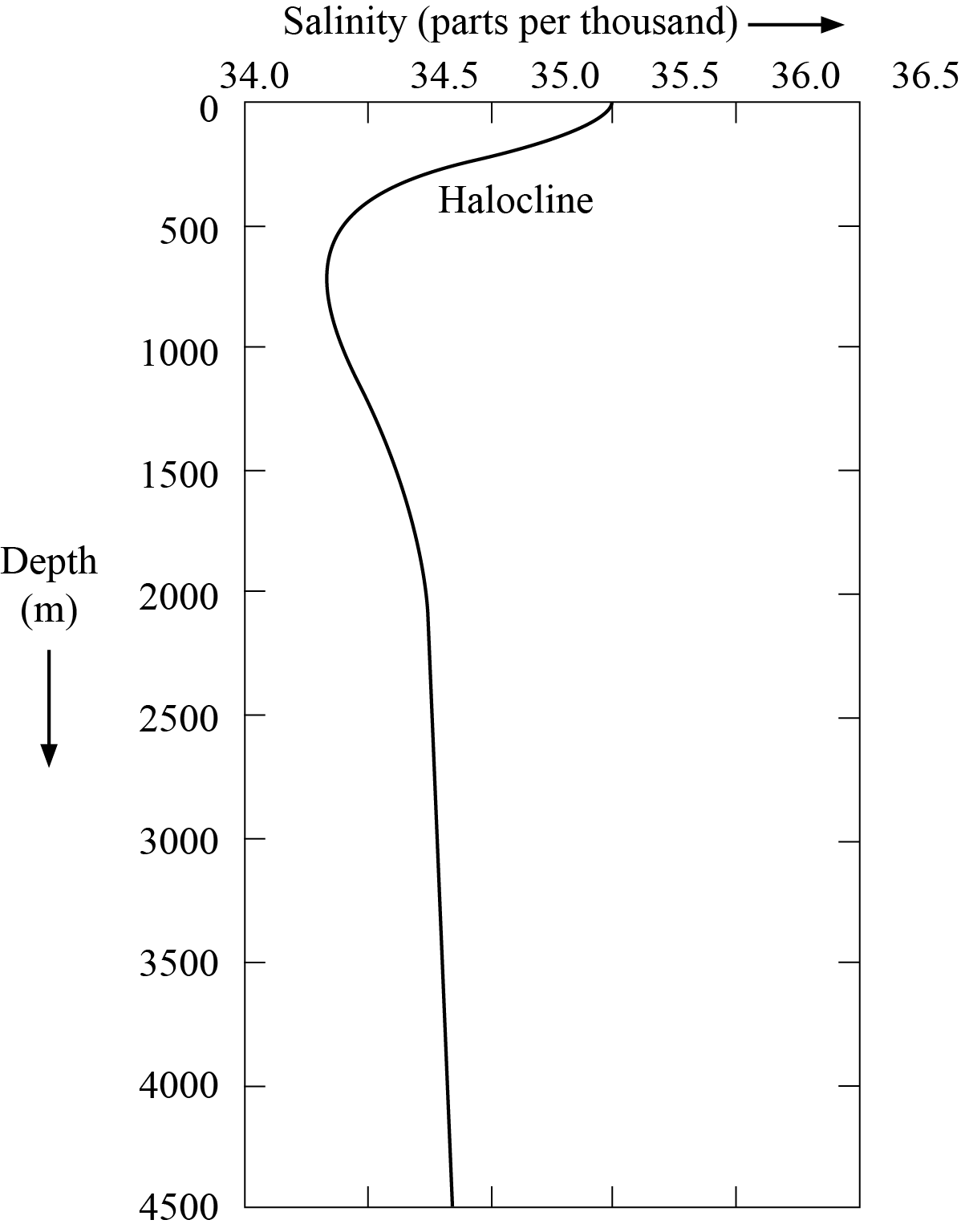| Date | November 2011 | Marks available | 10 | Reference code | 11N.2.bp.3 |
| Level | SL and HL | Paper | 2 | Time zone | |
| Command term | Discuss | Question number | 3 | Adapted from | N/A |
Question
The graph shows vertical variations in the salinity of ocean water.

[Source: http://cimss.ssec.wisc.edu/sage/oceanography/lesson4/images/sm_salinity_depth.jpg]
Describe the vertical variations in the salinity shown on the graph.
Explain what is meant by “oceanic conveyor belts”.
Suggest two reasons why oceanic conveyor belts are important.
Discuss the effects of El Niño on some coastal margins.
Markscheme
Rapid decrease down to around 500–800 metres [1 mark]. Increases steadily to around 2000 metres [1 mark]. Then stays the same/increases very slightly from 2000–4500 metres [1 mark].
Award 1 mark for quantification, for example, uses the salinity figures, or qualification of trends, for example, recognizes changes in the rate of decline.
Oceanic conveyor belts, or thermohaline circulations (THCs), refer to part of the large-scale ocean circulation [1 mark].
Award 1 mark for mention of either a cause or a pattern, for example, density gradients or the process of wind-driven surface currents.
Candidates may approach this question from the perspective of human importance and/or system importance.
Award 1 mark for identifying a valid reason and a further 1 mark for extension or exemplification, up to a maximum of 4 marks.
Likely responses include:
- Moderation of climates [1 mark], so the thermal growing season for agriculture is extended [1 mark].
- Importance because they transfer global heat energy and matter (solids, dissolved substances and gases) from latitude to latitude [1 mark]; if the circulation stopped it would cause significant climate change [1 mark].
- Currently the conveyer belts reduce temperature differences between basins [1 mark], therefore linking the earth’s oceans as a single global system [1 mark].
Candidates would be expected to briefly explain what is meant by El Niño and outline its characteristics. Reference should also be made to specific coastal margins.
Answers which provide support by using examples are likely to access the higher markbands. The effects may be physical, causing drought, flooding, coral bleaching, depletion of fish stocks or impacts on the food chain. These effects may be exacerbated by human activities such as the overfishing of anchovies in Peru. Drought may also cause people to take advantage of an opportunity to burn forests causing the smoke haze that affected south-east Asia in 1997 or resulted in the decimation of game animals in coastal southern Africa in 1992. It is possible that candidates may suggest an increase in frequency and/or severity of El Niño events due to global warming. El Niño may be connected to increased tropical storm damage and the damage to sea kelp in California, for example.
Strong answers will additionally look at positive impacts – the desert bloom in Peru, increased rainfall in arid areas and germination of plants, for example, in the Panamian rainforests. It is acceptable to use one case study, which can be at any scale. Varied approaches are acceptable.
To access bands E and F, the discussion should explore different perspectives, for example, human/physical, positive/negative, short-term/long-term.
Marks should be allocated according to the markbands.
Examiners report
Most candidates were able to describe changes in salinity very well.
Most candidates were able to explain oceanic conveyor belts.
Answers were much less secure and many candidates confused oceanic conveyor belts with surface currents.
Discussions were often strong, and virtually all answers included an accurate description of how El Niño works, showing a welcome improvement in the understanding of the event. At standard level the effects were often confined to the west coast of South America and effects in the western Pacific were ignored, but answers were, in most cases, accurate and relevant.

